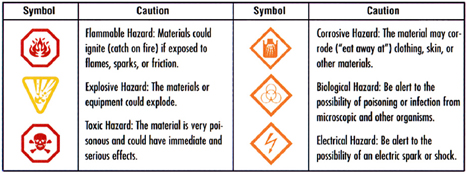Getting Started
You have learned that your home has many chemicals. Some products in your home, such as "green" cleaners, may be environmentally friendly. Other products may have harmful effects, especially if not used properly. In this activity, you will survey your home for chemical products and analyze your results.
Your Goal
Your goal in this unit task is to gather information for a Home Chemical Inventory. You will consider the use of hazardous products in your home, identify the safe handling, storage, and disposal of the products, and determine whether the products are acidic or basic. Then you will identify whether there are less hazardous or non-hazardous replacements for those products.
|
Criteria for Success
- Your inventory should include products from all areas of your home, such as the kitchen, bathroom, bedrooms, closets, office, garage, basement, shed, and so on.
- If any areas of your home do not include products with a home hazardous product symbol (HHPS) but do include non-hazardous alternatives, list those products as well.
- Your teacher may instead provide a number of product labels for you to complete this activity in the classroom.
What You Need to Know
The label of each hazardous consumer product in your home should include an HHPS to alert you about any hazards associated with the product. The illustration below shows six different symbols and the symbol colours for the three levels of hazard: Danger (red octagon), Warning (yellow triangle), and Caution (orange diamond).
What You Need
- HHPS chart (see below)
- product labels with HHPS
Caution
Take care in handling containers at home, ensuring that the lids remain securely fastened to the containers so that no spills occur. Take extra care if products are in difficult-to-reach cupboards or areas. After examining the labels, be sure to return products to their proper storage area, so that they stay out of reach of younger family members, etc.
|

